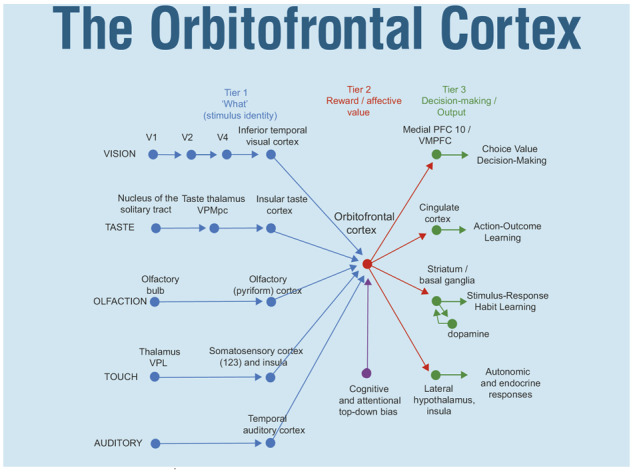- Record: found
- Abstract: found
- Article: found
The orbitofrontal cortex: reward, emotion and depression

Read this article at
Abstract
The orbitofrontal cortex in primates including humans is the key brain area in emotion, and in the representation of reward value and in non-reward, that is not obtaining an expected reward. Cortical processing before the orbitofrontal cortex is about the identity of stimuli, i.e. ‘what’ is present, and not about reward value. There is evidence that this holds for taste, visual, somatosensory and olfactory stimuli. The human medial orbitofrontal cortex represents many different types of reward, and the lateral orbitofrontal cortex represents non-reward and punishment. Not obtaining an expected reward can lead to sadness, and feeling depressed. The concept is advanced that an important brain region in depression is the orbitofrontal cortex, with depression related to over-responsiveness and over-connectedness of the non-reward-related lateral orbitofrontal cortex, and to under-responsiveness and under-connectivity of the reward-related medial orbitofrontal cortex. Evidence from large-scale voxel-level studies and supported by an activation study is described that provides support for this hypothesis. Increased functional connectivity of the lateral orbitofrontal cortex with brain areas that include the precuneus, posterior cingulate cortex and angular gyrus is found in patients with depression and is reduced towards the levels in controls when treated with medication. Decreased functional connectivity of the medial orbitofrontal cortex with medial temporal lobe areas involved in memory is found in patients with depression. Some treatments for depression may act by reducing activity or connectivity of the lateral orbitofrontal cortex. New treatments that increase the activity or connectivity of the medial orbitofrontal cortex may be useful for depression. These concepts, and that of increased activity in non-reward attractor networks, have potential for advancing our understanding and treatment of depression. The focus is on the orbitofrontal cortex in primates including humans, because of differences of operation of the orbitofrontal cortex, and indeed of reward systems, in rodents. Finally, the hypothesis is developed that the orbitofrontal cortex has a special role in emotion and decision-making in part because as a cortical area it can implement attractor networks useful in maintaining reward and emotional states online, and in decision-making.
Abstract
The orbitofrontal cortex is involved in emotion, reward value and reward-related decision-making. Rolls et al. describe how it implements these functions, and the effects of damage. In depression, the lateral orbitofrontal cortex has increased functional connectivity and sensitivity to non-reward; and the medial orbitofrontal cortex has decreased connectivity and sensitivity to reward.
Graphical Abstract
Related collections
Most cited references221
- Record: found
- Abstract: found
- Article: not found
Power failure: why small sample size undermines the reliability of neuroscience.
- Record: found
- Abstract: found
- Article: not found
The precuneus: a review of its functional anatomy and behavioural correlates.
- Record: found
- Abstract: found
- Article: not found
